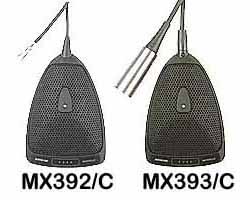
The Shure Microflex
boundary microphone

General
Shure Microflex MX300 Series microphones are surface-mounted electret condenser microphones designed primarily for mounting on conference tables, stage floors, and lecterns. Their high sensitivity and wide frequency range make them especially suitable for picking up speech and vocals in sound reinforcement and recording applications. Interchangeable cartridges provide the installer with greater flexibility and make it possible to easily reconfigure microphone coverage as the need arises. The MX392 and MX393 models include an internal preamplifier.
MX300 Series microphones take advantage of the principle that, at a barrier or boundary, the sound pressure level doubles. When placed near a sufficiently large boundary surface, the microphone has 6 dB higher sensitivity and approximately 3 dB greater direct-to-reverberant sound ratio.
Features
- Flat frequency response across the vocal range for uncolored sound
- Interchangeable cardioid, supercardioid, and omni-directional cartridges that provide choices for applications
- Sleek, low-profile design for unobtrusive appearance
- Balanced transformerless output for increased immunity to noise over long cable runs
- Low susceptibility to electromagnetic hum and RFI
- Programmable on/off switch and LED on/off indicator Logic input/output terminals for remote control or use with automatic mixers (MX392 models only)
Model Variations
- MX392 Models: Surface-mount microphone; includes a programmable membrane on/off switch, logic input/output terminals, an on/off indicator LED, screw terminal connections, and attached unterminated cable.
- MX393 Models: Surface-mount microphone; includes a programmable membrane on/off switch, an on/off indicator LED, and a Switchcraft Tini Q-G) connector.
Selecting a Cartridge
All Microflex microphones are available with any one of three interchangeable cartridges. The polar pattern of the original cartridge used in a particular microphone is indicated by the model number suffix: C = Cardioid, S = Supercardioid, O = Omni-directional
- Cardioid (C). Recommended for general sound reinforcement applications.
Pickup angle (–3 dB) = 130°.
- Supercardioid (S). Recommended for sound reinforcement applications requiring narrow or more distant coverage.
Pickup angle (–3 dB) = 115°.
- Omni-directional (O). Recommended for recording or remote monitoring applications.
Pickup angle (–3 dB) = 360°.
Microphone Placement
To maintain the flattest possible low-frequency response and optimum rejection of background noise, place the microphone on a flat surface that is as large as possible. The surface can be a floor, table, or lectern.
Avoid locating microphones near reflective surfaces other than the boundary surface (i.e., beveled sides of pulpits or overhanging shelves). Failure to do so will result in increased levels of reverberant sound.